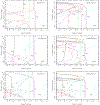Chemical kinetics on extrasolar planets
- PMID: 24664912
- PMCID: PMC6380885
- DOI: 10.1098/rsta.2013.0073
Chemical kinetics on extrasolar planets
Abstract
Chemical kinetics plays an important role in controlling the atmospheric composition of all planetary atmospheres, including those of extrasolar planets. For the hottest exoplanets, the composition can closely follow thermochemical-equilibrium predictions, at least in the visible and infrared photosphere at dayside (eclipse) conditions. However, for atmospheric temperatures approximately <2000K, and in the uppermost atmosphere at any temperature, chemical kinetics matters. The two key mechanisms by which kinetic processes drive an exoplanet atmosphere out of equilibrium are photochemistry and transport-induced quenching. I review these disequilibrium processes in detail, discuss observational consequences and examine some of the current evidence for kinetic processes on extrasolar planets.
Keywords: atmospheric chemistry; chemical kinetics; exoplanets; extrasolar planets; photochemistry; planetary atmospheres.
Figures





References
-
- Deming D, Seager S 2009. Light and shadow from distant worlds. Nature 462, 301–306. - PubMed
-
- Seager S(Editor) 2010. Exoplanets. Tucson, AZ: Univ. Arizona Press.
-
- Schneider J, Le Sidaner P, Savalle R & Zolotukhin I 2013. The Extrasolar Planets Encyclopaedia. See http://exoplanet.eu/catalog/.
-
- Borucki WJ, Koch DG, Basri G, Batalha N, Brown TM, Bryson ST, Caldwell D, Christensen-Dalsgaard J, Cochran WD, DeVore E, et al. 2011. Characteristics of planetary candidates observed by Kepler. II. Analysis of the first four months of data. Astrophys. J 736, 19.
-
- Batalha N, Rowe JF, Bryson ST, Barclay T, Burke CJ, Caldwell DA, Christiansen JL, Mullally F, Thompson SE, Brown TM, et al. 2012. arXiv: 1202.5852.
Grants and funding
LinkOut - more resources
Full Text Sources
Other Literature Sources

